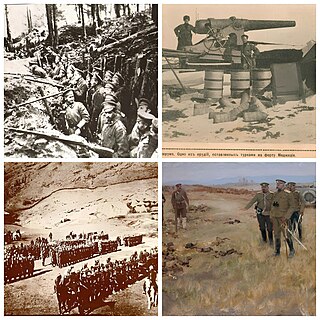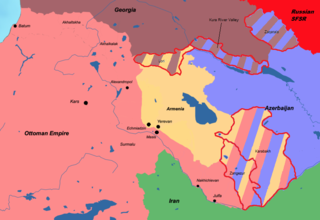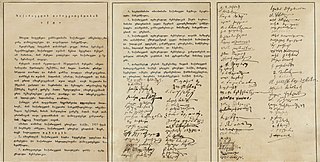
The Treaty of Brest-Litovsk was a separate peace treaty signed on 3 March 1918 between Soviet Russia and the Central Powers, by which Russia withdrew from World War I. The treaty, which followed months of negotiations after the armistice on the Eastern Front in December 1917, was signed at Brest-Litovsk.

The Transcaucasian Democratic Federative Republic was a short-lived state in the Caucasus that included most of the territory of the present-day Armenia, Azerbaijan and Georgia, as well as parts of Russia and Turkey. The state lasted only for a month before Georgia declared independence, followed shortly after by Armenia and Azerbaijan.

The Azerbaijan Democratic Republic, also known as the Azerbaijan People's Republic, was the first secular democratic republic in the Turkic and Muslim worlds. The ADR was founded by the Azerbaijani National Council in Tiflis on 28 May 1918 after the collapse of the Transcaucasian Democratic Federative Republic, and ceased to exist on April 28, 1920. Its established borders were with Russia to the north, the Democratic Republic of Georgia to the north-west, the Republic of Armenia to the west, and Iran to the south. It had a population of around 3 million. Ganja was the temporary capital of the Republic as Baku was under Bolshevik control. The name of "Azerbaijan" which the leading Musavat party adopted, for political reasons, was, prior to the establishment of the Azerbaijan Democratic Republic in 1918, exclusively used to identify the adjacent region of contemporary northwestern Iran.

The Caucasus campaign comprised armed conflicts between the Russian Empire and the Ottoman Empire, later including Armenia, Azerbaijan, Georgia, the Mountainous Republic of the Northern Caucasus, the German Empire, the Central Caspian Dictatorship, and the British Empire, as part of the Middle Eastern theatre during World War I. The Caucasus campaign extended from the South Caucasus to the Armenian Highlands region, reaching as far as Trabzon, Bitlis, Mush and Van. The land warfare was accompanied by naval engagements in the Black Sea.

The Islamic Army of the Caucasus was a military unit of the Ottoman Empire formed on July 10, 1918. The Ottoman Minister of War, Enver Pasha, ordered its establishment, and it played a major role during the Caucasus Campaign of World War I.

The Treaty of Batum was signed in Batum on 4 June 1918, between the Ottoman Empire and the three Transcaucasian states: the First Republic of Armenia, the Azerbaijan Democratic Republic and the Democratic Republic of Georgia. It was the first treaty of the First Republic of Armenia and the Azerbaijan Democratic Republic and had 14 articles.

The occupation of Western Armenia by the Russian Empire during World War I began in 1915 and was formally ended by the Treaty of Brest-Litovsk. It was sometimes referred to as the Republic of Van by Armenians. Aram Manukian of Armenian Revolutionary Federation was the de facto head until July 1915. It was briefly referred to as "Free Vaspurakan". After a setback beginning in August 1915, it was re-established in June 1916. The region was allocated to Russia by the Allies in April 1916 under the Sazonov–Paléologue Agreement.

Hovhannes Kajaznuni or Katchaznouni was an Armenian architect and politician who served as the first prime minister of the First Republic of Armenia from 6 June 1918 to 7 August 1919. He was a member of the Armenian Revolutionary Federation.

The Battle of Baku took place in August and September 1918 between the Ottoman–Azerbaijani coalition forces led by Nuri Pasha and Bolshevik–ARF Baku Soviet forces, later succeeded by the British–Armenian–White Russian forces led by Lionel Dunsterville and saw Soviet Russia briefly re-enter the war. The battle took place during World War I, was a conclusive part of the Caucasus Campaign, but a beginning of the Armenian–Azerbaijani War.

Akaki Chkhenkeli was a Georgian Social Democratic politician and publicist who acted as one of the leaders of the Menshevik movement in Russia and Georgia. In 1918 he served as the prime minister and foreign minister of the Transcaucasian Democratic Federative Republic, and then became foreign minister of the Democratic Republic of Georgia. In 1921 he was appointed the Georgian Minister to France, though was unable to serve as the Red Army invaded Georgia. His younger brother was the linguist Kita Tschenkéli.

The German Caucasus expedition was a military expedition sent in late May 1918, by the German Empire to the formerly Russian Transcaucasia during the Caucasus Campaign of World War I. Its prime aim was to stabilize the pro-German Democratic Republic of Georgia and to secure oil supplies for Germany by preventing the Ottoman Empire from gaining access to the oil reserves near Baku on the Absheron Peninsula.

The Special Transcaucasian Committee was established on March 9, 1917, with Member of the State Duma V. A. Kharlamov as Chairman, to replace the Imperial Viceroy Grand Duke Nikolai Nikolaevich and with special instruction to establish civil administrations in areas occupied in the course of the war on the Caucasian front by the Russian Provisional Government in the Transcaucasus as the highest organ of the civil administrative body. Commissars were appointed for the Terek Oblast and the Kuban Oblast, and these as well as the Committee were to carry on relations with central government institutions through a Commissar for Caucasian Affairs in Petrograd attached to the Provisional Government.

Christophor Araratov, also known as Khachatur Araratian and Christapor Araratian, was an Armenian career officer of the Russian Imperial Army. He was promoted to the rank of Major General of the Armenian army during its fight for independence during and after World War I. Araratov participated in the 1918 battles of Sardarapat and Karakilisa against Turkish invaders.
The Armistice of Erzincan was an agreement to suspend hostilities during World War I signed by the Ottoman Empire and Transcaucasian Commissariat in Erzincan on 18 December 1917. The armistice brought temporary peace to the Caucasian and Persian Fronts until 12 February, when the fighting was resumed.

The Trebizond Peace Conference was a conference held between 14 March and 13 April 1918 in Trebizond between the Ottoman Empire and a delegation of the Transcaucasian Diet and government. The opening session was on 14 March 1918. The representatives were Rear-Admiral Hüseyin Rauf Bey for the Ottoman Empire, and Akaki Chkhenkeli, Khalil bey Khasmammadov, Alexander Khatisian etc. as the Transcaucasian delegation.

The Transcaucasian Seim was a representative and legislative body of state power in the Transcaucasus, convened by the Transcaucasian Commissariat in Tiflis on 23 February 1918. Its members consisted of Russian Constituent Assembly deputies elected in Transcaucasia, as well as representatives of the various political parties of Transcaucasia. Its chairman was Nikolay Chkheidze of the Social Democratic Party of Georgia.

The Batum oblast was a province (oblast) of the Caucasus Viceroyalty of the Russian Empire, with the Black Sea port of Batum as its administrative center. The Batum oblast roughly corresponded to most of present-day southwestern Georgia, and part of the Artvin Province of Turkey.
The Greek Caucasus Division, was a division of the Russian Army composed of ethnic Greeks from the Caucasus and Pontus regions during World War I. Formed in the closing stages of the Caucasus Campaign, it protected the local Greek population from attacks by Muslim militias and the Ottoman army. It was disbanded a year later as a result of the Treaty of Poti.

The Battle of Binagadi took place between 26 and 31 August 1918 during World War I and saw Soviet Russia briefly re-enter the war. Ottoman–Azerbaijani coalition forces led by Nuri Pasha fought British–Armenian–White Russian forces led by Lionel Dunsterville. It was an important part of the Battle of Baku.

The Georgian Declaration of Independence was the declaration of independence of the Democratic Republic of Georgia on 26 May 1918. It established a Georgian state from the Transcaucasian Democratic Federative Republic, a federation between Armenia, Azerbaijan, and Georgia in the wake of the 1917 Russian Revolution. It was proclaimed in Tiflis, the main city of Georgia and the new capital of Georgia.















